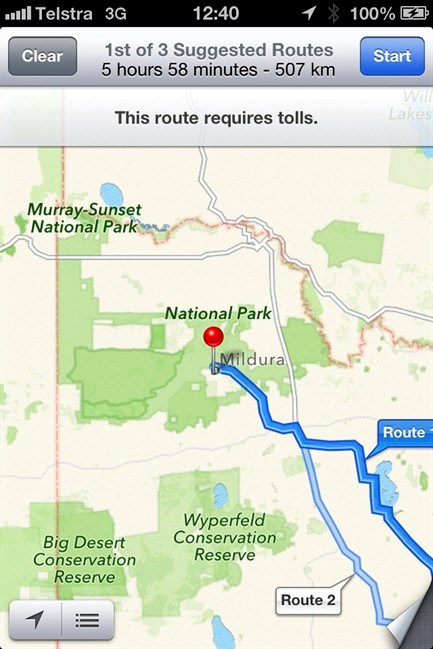SYDNEY - The city of Mildura is not at the end of a dirt road in the Australian bush, in tire-choking desert sand far from food and water. Unfortunately, Apple's much-maligned mapping application thinks it is.
More than two months after Apple's CEO apologized for errors in its Maps service, Australian police say the app is "potentially life threatening" because of the bad directions it has given to the southern city. On Tuesday, a police official said Apple had "sort of half-fixed" the problem.
Victoria state police say they've had to rescue several Mildura-bound drivers who were directed by the app to remote Murray Sunset National Park, about 70 kilometres (44 miles) away. Some were stranded for 24 hours without food or water, and had to walk long distances through tough terrain to access phone reception.
"Police are extremely concerned as there is no water supply within the park and temperatures can reach as high as 46 degrees (115 degrees Fahrenheit), making this a potentially life threatening issue," police said in a statement.
The 5,000-square-kilometre (1,900-square-mile) park has desert-like conditions, scorching temperatures and virtually no mobile phone reception.
In the past 30 days, six people have been stranded after turning into the park via a dirt road the Maps application recommends, Mildura police inspector Simon Clemence said. Some were able to get out on their own but others needed to be rescued by police, he said.
The track eventually opens up into rough desert terrain that is accessible only to 4-wheel-drive vehicles. That's where cars are getting stuck in the sand, Clemence said.
"If you're stuck out there in that you haven't prepared, you've got nothing, you could be in a fair bit of trouble," he said.
Earlier this year, Apple dropped Google Maps from its mobile operating systems in favour of its own mapping application, which was quickly and widely criticized for bad directions, misplaced landmarks and missing towns. Apple CEO Tim Cook apologized for the mapping service in September and promised to improve it.
"We screwed up and we are putting the weight of the company behind correcting it," Cook said in an interview aired Thursday on NBC's "Rock Center."
Apple spokeswoman Fiona Martin declined to comment Tuesday, and referred The Associated Press to Cook's apology.
Clemence said police received no response when they tried to contact Apple, but that on Tuesday morning — a day after police went public with the problem — it appeared that the company had tried to fix it.
Drivers coming from the southern city of Adelaide are now correctly directed by the Maps application to Mildura, Clemence said. But drivers from Melbourne are still sent into the park.
"So 50 per cent of the people are safe and 50 per cent of the people aren't," Clemence said with a chuckle. "So they sort of half-fixed it."
With temperatures this week expected to soar in the region, Clemence said it's critical that the directions are corrected quickly.
"It's a pretty serious problem," Clemence said. "There's a fair amount of responsibility on Apple to get this fixed."



